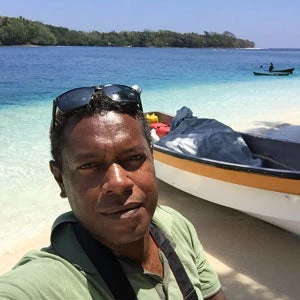
Geographically, the capital of Solomon Islands, Honiara, is a hilly city, a maze of ridges and valleys.
In front of me, concrete steps descend 30 meters down the face of a ridge, winding their way down in a gravity-defying manner; nothing else stands on the slope, it’s simply too steep.
The steps are part of a system of footpaths that link communities of thousands of people below to the main public road above.
Over the past 60 years as Honiara has developed, so too have informal settlements. These are often located at the bottom of steep valleys without basic services such as roads, water and electricity.
With poor road access in the settlements, a young mother explained to me how a simple task like taking a sick child to the clinic could take hours, even longer in rainy weather, with safety risks to both mother and child. That was the norm before the rise of “Jacob’s ladders”.
That’s the name the steps have been given, based on the Biblical patriarch Jacob’s ladder to heaven in the Book of Genesis. These ladders have given residents of Honiara’s settlements access to schools, clinics, public transport and to small stores that stock the essentials.
Jacobs’ ladders have changed life in settlements and have become the most sought-after infrastructure provided by the Rapid Employment Project in recent years.
To build the steps, community themselves supplied the labor while the project provided technical support and materials.
Jobs created to build a ladder put money back into the communities and provided important professional experiences for the countless number of unemployed youth, eager to work but with limited access to opportunities.
Building a Jacob’s Ladder is no easy task. Workers dig foundations, climb and carry bags of cement along steep ridges, all under Honiara’s sweltering sun.
A typical Jacob’s Ladder could take several months of hard work to build. But communities are well aware of the importance of the infrastructure to their future and work hard to maintain their enthusiasm and commitment to the project.
Community members that have proven their skills are even taken on by the project to help build similar infrastructure in other communities.
While the creation of labor in the construction phase meets its mandate, it’s the long-term impact of increased access to city services that has made the project a success in the eyes of Solomon Islanders.
Across Honiara, where ladders and footpaths have become integrated into everyday life, thousands use them to walk their children to school, go to work in the morning, and simply to get on with their lives, even in the face of bad weather.
The Jacob’s Ladders have helped save lives, enabling members of the Koa Hill community to move to higher ground during flash floods in April 2014.
In West Honiara, an even bigger network of footpaths run for 1.2 kilometers (2 miles) linking up the settlements of Gwaimaoa, Namoliki, Antioch, Matariu and Mata Valley. Over 2,600 people directly benefit from this network of Jacob’s Ladders and footpaths.
The Jacob’s Ladders, through the Rapid Employment Project, have transformed lives and will continue to provide greater opportunity for Honiara’s vulnerable.


Join the Conversation